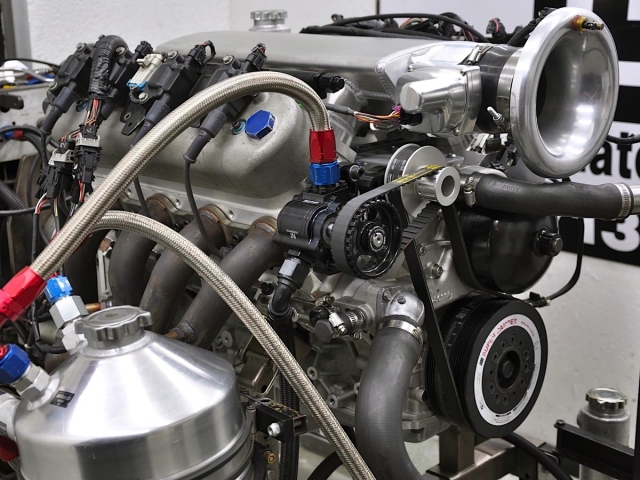This 427ci LS7 built by Late Model Engines [1] (LME) made just over 630 horsepower at 6,800 rpm on its initial dyno run, but it will soon benefit from a pair of turbos before going into the customer’s street car. In fact, the owner already has a similar setup using a stock block that makes 1,100 horsepower to the rear wheels, but now he wants to “turn it up.”
 [2]That request prompted LME engine builder Eric Hatfield to provide a solid foundation in the form of a solid-deck RHS [3] aluminum block. Basically, the decks were CNC machined to fully expose the water pockets about a half-inch deep. LME then machined matching plugs that press fit into place. Both decks were resurfaced, then coolant holes were drilled to match the Cometic [4] head gaskets, and the head-bolt holes were drilled and tapped for 1/2-inch studs.
[2]That request prompted LME engine builder Eric Hatfield to provide a solid foundation in the form of a solid-deck RHS [3] aluminum block. Basically, the decks were CNC machined to fully expose the water pockets about a half-inch deep. LME then machined matching plugs that press fit into place. Both decks were resurfaced, then coolant holes were drilled to match the Cometic [4] head gaskets, and the head-bolt holes were drilled and tapped for 1/2-inch studs.
“It really stiffens up the deck,” adds Hatfield.
The rotating assembly comprises a Callies [5] billet crank with an ATI [6] damper, Oliver [7] rods and LME pistons made by Wiseco [8] that are machined with lateral gas ports and fitted with Total Seal [9] rings. The pistons have a taller compression height to help add strength for boost applications. The compression ratio is 9.5:1 or 10:1, depending on the head gasket. Lubrication is supplied by a Katech [10] high-volume pump (to help feed the turbos) in the stock location and an auxiliary ARE [11] single-stage external pump that helps scavenge and pull about 11 inches of vacuum from the pan.
With the exception of a little hand blending in the ports, the LS7 heads were untouched before being fitted with titanium intake valves, Inconel exhaust and Yella Terra [14] rockers. Cam timing is in the “240s for intake, 250s for exhaust” with .650-inch lift. Induction is through a custom sheet-metal intake manifold from Scoggin-Dickey Parts Centers [15].
“It’s designed for boosted engines with bracing so the top can’t balloon,” adds Hatfield.
The customer will swap over the fuel system and turbos after receiving the new engine. Expected horsepower could be 1,200 to 1,500 — depending on how much boost he’s willing to “turn it up!”
